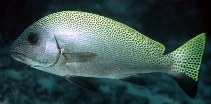| Family: |
Haemulidae (Grunts), subfamily: Plectorhinchinae |
| Max. size: |
45 cm SL (male/unsexed) |
| Environment: |
benthopelagic; marine; depth range 3 - 40 m |
| Distribution: |
Indo-West Pacific: Indonesia, Borneo and the Philippines. Also reported from Australia, Timor Sea (Ashmore Reef) and Myanmar. |
| Diagnosis: |
Dorsal spines (total): 10-11; Dorsal soft rays (total): 22-24; Anal spines: 3-3; Anal soft rays: 6-7. Tubed lateral line scales 55-57; outer row of teeth in jaws slightly enlarged, movable; swim bladder with 3 short anterior projections; third or fourth dorsal spine longest, 1.8-1.9 in head; first dorsal spine 1.7-2.3 in length of second; interspinous membrane of dorsal fin not incised; pelvic fins reaching vent or slightly beyond, 1.2-1.3 in head; body light yellow dorsally, shading to pale silvery grey on sides and ventrally, with numerous small dark brown spots, which are smaller and form oblique rows on body below lateral line; head light purplish grey with numerous small dark brown spots, opercular membrane black; dorsal fin and upper 3/4 of caudal fin with small dark spots; lower 1/4 of caudal fin black; anal and pelvic fins mainly black (Ref. 44143); dorsal and caudal fins mainly yellow, caudal fin with broad black lower edge margin, caudal fin may be slightly emarginate to truncate; body depth 2.4-2.6 in SL (Ref. 90102). Juveniles from 13.3 cm SL with spots about size of pupil on head, body, dorsal and caudal fins becoming progressively smaller and more numerous with age; juveniles and subadults up to 25.4 cm SL with narrow discontinuous wavy lines on operculum and cheeks, extending to about level of anterior margin of eye (with lines breaking up into spots in larger specimens) (Ref. 44143). Large juveniles have spots in longitudinal rows and also solid stripes (Ref. 90102). |
| Biology: |
Juveniles in estuaries and silty reefs on open substrates with remote outcrops or reef or debris. Adults on deep reefs along walls with large caves. Often in small aggregations in depths of 30 m or more (Ref. 48635). |
| IUCN Red List Status: |
Not Evaluated (N.E.) Ref. (130435)
|
| Threat to humans: |
harmless |
Source and more info: www.fishbase.org. For personal, classroom, and other internal use only. Not for publication.
